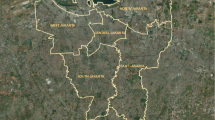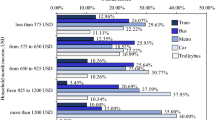Abstract
This research focuses on understanding the impact of the type of shopping activity (general shopping goods, grocery, prepared meals) on shopping channel (in-person vs. online shopping) preferences. To better understand consumer decisions in the post-COVID era, this study used a large-scale consumer behaviour survey in New Delhi, India, with 1798 respondents to develop multivariate ordered probit models (MORP) involving in-person shopping travel frequencies (INFs) and online delivery frequencies (ONFs). Considering the online and physical shopping decision counterparts in a joint modelling framework enabled us to quantify the determinants of online shopping and in-person shopping frequencies and how they vary across consumption categories. The influences of demographic characteristics (e.g., car ownership, income, mode choice) and attitudes (e.g., tech-savviness, attitude towards perceived risks of online shopping) were delineated in the analysis by treating them as exogenous predictors. The model estimation results and discussions in this study are expected to help advance the understanding of how the emergence of online shopping and delivery-based services are influencing activity-travel patterns and choices in the aftermath of the pandemic.



Similar content being viewed by others
References
Wang K, Gao Y, Liu Y, Nurul Habib K (2023) Exploring the choice between in-store versus online grocery shopping through an application of Semi-Compensatory Independent Availability Logit (SCIAL) model with latent variables. J Retail Consum Serv 71:103191. https://doi.org/10.1016/j.jretconser.2022.103191
Shaw N, Eschenbrenner B, Baier D (2022) Online shopping continuance after COVID-19: a comparison of Canada, Germany and the United States. J Retail Consum Serv 69:103100. https://doi.org/10.1016/j.jretconser.2022.103100
Pandey S, Chawla D (2014) E-lifestyles of Indian online shoppers: a scale validation. J Retail Consum Serv 21:1068–1074. https://doi.org/10.1016/j.jretconser.2014.06.012
Yousefi Z, Dadashpoor H (2020) How do ICTs affect urban spatial structure? A systematic literature review. J Urban Technol 27:47–65. https://doi.org/10.1080/10630732.2019.1689593
Bjerkan KY, Bjørgen A, Hjelkrem OA (2020) E-Commerce and prevalence of Last mile practices. Transp Res Procedia 46:293–300. https://doi.org/10.1016/j.trpro.2020.03.193
Ferrell CE (2005) Home-based teleshopping and shopping travel: where do people find the time? Transp Res Rec 1926(1):212–223. https://doi.org/10.1177/0361198105192600125
Motte-Baumvol B, Belton-Chevallier L, Dablanc L, Morganti E, Belin-Munier C (2017) Spatial dimensions of e-shopping in France. Asian Transport Studies. 4(3):585–600
Suel E, Polak JW (2017) Development of joint models for channel, store, and travel mode choice: grocery shopping in London. Transp Res Part A Policy Pract 99:147–162. https://doi.org/10.1016/j.tra.2017.03.009
Suel E, Le Vine S, Polak J (2015) Empirical application of expenditure diary instrument to quantify relationships between in-store and online grocery shopping: case study of greater London. Transp Res Rec 2496:45–54. https://doi.org/10.3141/2496-06
Shi K, De Vos J, Yang Y, Witlox F (2019) Does E-shopping replace shopping trips? Empirical evidence from Chengdu, China. Transp Res Part A Policy Pract 122:21–33. https://doi.org/10.1016/j.tra.2019.01.027
Edrisi A, Ganjipour H (2017) The interaction between e-shopping and shopping trip, Tehran. Proceedings of the Institution of Civil Engineers - Municipal Engineer 170(4):239–246. https://doi.org/10.1680/jmuen.16.00031
Farag S, Weltevreden J, van Rietbergen T, Dijst M, van Oort F (2006) E-shopping in the Netherlands: does geography matter? environment and planning B: Planning and Design 33(1):59–74. https://doi.org/10.1068/b31083
Lachapelle U, Jean-Germain F (2019) Personal use of the internet and travel: evidence from the Canadian general social survey’s 2010 time use module. Travel Behav Soc 14:81–91. https://doi.org/10.1016/j.tbs.2018.10.002
Lee RJ, Sener IN, Mokhtarian PL, Handy SL (2017) Relationships between the online and in-store shopping frequency of Davis, California residents. Transp Res Part A Policy Pract 100:40–52. https://doi.org/10.1016/j.tra.2017.03.001
Rotem-Mindali O (2010) E-tail versus retail: the effects on shopping related travel empirical evidence from Israel. Transp Policy (Oxf) 17:312–322. https://doi.org/10.1016/j.tranpol.2010.02.005
Xi G, Cao X, Zhen F (2020) The impacts of same day delivery online shopping on local store shopping in Nanjing, China. Transp Res Part A Policy Pract 136:35–47. https://doi.org/10.1016/j.tra.2020.03.030
Zhen F, Cao X, Mokhtarian PL, Xi G (2016) Associations between online purchasing and store purchasing for four types of products in Nanjing, China. Transp Res Rec 2566:93–101. https://doi.org/10.3141/2566-10
Ding Y, Lu H (2017) The interactions between online shopping and personal activity travel behavior: an analysis with a GPS-based activity travel diary. Transportation 44(2):311–324. https://doi.org/10.1007/s11116-015-9639-5
Hiselius LW, Rosqvist LS, Adell E (2015) Travel behaviour of online shoppers in Sweden. Transp Telecommun 16(1):21–30. https://doi.org/10.1515/ttj-2015-0003
Tandon S (2022) E-commerce penetration grew fivefold during COVID in India [WWW Document]. Mint News. https://www.livemint.com/news/india/ecommerce-penetration-grew-fivefold-during-covid-11659113634707.html
Mortimer G, Lucila M, Andrade O, Fazal-e-hasan SM (2024) From traditional to transformed: examining the pre- and post-COVID consumers’ shopping mall experiences. J Retail Consum Serv 76
Gulfraz MB, Sufyan M, Mustak M, Salminen J, Srivastava DK (2022) Understanding the impact of online customers’ shopping experience on online impulsive buying: a study on two leading E-commerce platforms. J Retail Consum Serv 68:103000. https://doi.org/10.1016/j.jretconser.2022.103000
Ferrell CE (2005) Home-based teleshopping and shopping travel: where do people find the time? Transp Res Rec. https://doi.org/10.3141/1926-25
Weltevreden JWJ, Rotem-Mindali O (2009) Mobility effects of b2c and c2c e-commerce in the Netherlands: a quantitative assessment. J Transp Geogr 17:83–92. https://doi.org/10.1016/j.jtrangeo.2008.11.005
Etminani-Ghasrodashti R, Hamidi S (2020) Online shopping as a substitute or complement to in-store shopping trips in Iran? Cities 103:102768. https://doi.org/10.1016/j.cities.2020.102768
Dias FF, Lavieri PS, Sharda S, Khoeini S, Bhat CR, Pendyala RM, Pinjari AR, Ramadurai G, Srinivasan KK (2020) A comparison of online and in-person activity engagement: the case of shopping and eating meals. Transp Res Part C Emerg Technol 114:643–656. https://doi.org/10.1016/j.trc.2020.02.023
Spurlock CA, Todd-Blick A, Wong-Parodi G, Walker V (2020) Children, income, and the impact of home delivery on household shopping trips. Transp Res Rec. https://doi.org/10.1177/0361198120935113
Calderwood E, Freathy P (2014) Consumer mobility in the Scottish isles: the impact of internet adoption upon retail travel patterns. Transp Res Part A Policy Pract 59:192–203. https://doi.org/10.1016/j.tra.2013.11.012
Zhou Y, Wang X (2014) Explore the relationship between online shopping and shopping trips: an analysis with the 2009 NHTS data. Transp Res Part A Policy Pract 70:1–9. https://doi.org/10.1016/j.tra.2014.09.014
Cao XJ, Xu Z, Douma F (2012) The interactions between e-shopping and traditional in-store shopping: an application of structural equations model. Transportation (Amst) 39:957–974. https://doi.org/10.1007/s11116-011-9376-3
Weltevreden JWJ, Rietbergen TV (2007) The role of perceived city centre attractiveness. Tijdschr Econ Soc Geogr 98:68–85
Farag S, Schwanen T, Dijst M, Faber J (2007) Shopping online and/or in-store? A structural equation model of the relationships between e-shopping and in-store shopping. Transp Res Part A Policy Pract 41(2):125–141. https://doi.org/10.1016/j.tra.2006.02.003
Zafri NM, Khan A, Jamal S, Alam BM (2022) Risk perceptions of COVID-19 transmission in different travel modes. Transp Res Interdiscip Perspect 13:100548. https://doi.org/10.1016/j.trip.2022.100548
Pani A, Mishra S, Golias M, Figliozzi M (2020) Evaluating public acceptance of autonomous delivery robots during COVID-19 pandemic. Transp Res D Transp Environ 89:102600. https://doi.org/10.1016/j.trd.2020.102600
De Vos J (2020) The effect of COVID-19 and subsequent social distancing on travel behavior. Transp Res Interdiscip Perspect. https://doi.org/10.1016/j.trip.2020.100121
Verhoef PC, Kannan PK, Inman JJ (2015) From multi-channel retailing to omni-channel retailing. J Retail 91(2):174–181. https://doi.org/10.1016/j.jretai.2015.02.005
Lesser IA, Nienhuis CP (2020) The impact of COVID-19 on physical activity behaviour and well-being of canadians. Int J Environ Res Public Health 17(11):3899. https://doi.org/10.3390/ijerph17113899
Szász L et al (2022) The impact of COVID-19 on the evolution of online retail: the pandemic as a window of opportunity. J Retail Consum Serv 69. https://doi.org/10.1016/j.jretconser.2022.103089
Bhat CR (2018) New matrix-based methods for the analytic evaluation of the multivariate cumulative normal distribution function. Transp Res Part B Methodol 109:238–256. https://doi.org/10.1016/j.trb.2018.01.011
Pani A, Mishra S, Sahu P (2022) Developing multi-vehicle freight trip generation models quantifying the relationship between logistics outsourcing and insourcing decisions. Transp Res E Logist Transp Rev 159:102632. https://doi.org/10.1016/j.tre.2022.102632
Molin E, Mokhtarian P, Kroesen M (2016) Multimodal travel groups and attitudes: a latent class cluster analysis of Dutch travelers. Transp Res Part A Policy Pract 83:14–29. https://doi.org/10.1016/j.tra.2015.11.001
Weller BE, Bowen NK, Faubert SJ (2020) Latent Class Analysis: A Guide to Best Practice. J Black Psychol 46(4):287–311. https://doi.org/10.1177/0095798420930932
Kedia A, Kusumastuti D, Nicholson A (2019) Establishing collectionand delivery points to encourage the use of active transport:a case study in New Zealand using a consumer-centric approach. Sustainability 11(22):6255. https://doi.org/10.3390/su11226255
Author information
Authors and Affiliations
Corresponding author
Ethics declarations
Conflict of interest
On behalf of all authors, the corresponding author states that there is no conflict of interest.
Additional information
Publisher's Note
Springer Nature remains neutral with regard to jurisdictional claims in published maps and institutional affiliations.
Rights and permissions
Springer Nature or its licensor (e.g. a society or other partner) holds exclusive rights to this article under a publishing agreement with the author(s) or other rightsholder(s); author self-archiving of the accepted manuscript version of this article is solely governed by the terms of such publishing agreement and applicable law.
About this article
Cite this article
Pani, A., Unnikrishnan, A., Sinha, S. et al. Shopping Travel Behaviour Trade-Offs Between Physical Stores and Online Deliveries: Post-COVID Scenario in New Delhi, India. Transp. in Dev. Econ. 10, 17 (2024). https://doi.org/10.1007/s40890-024-00203-3
Received:
Accepted:
Published:
DOI: https://doi.org/10.1007/s40890-024-00203-3




